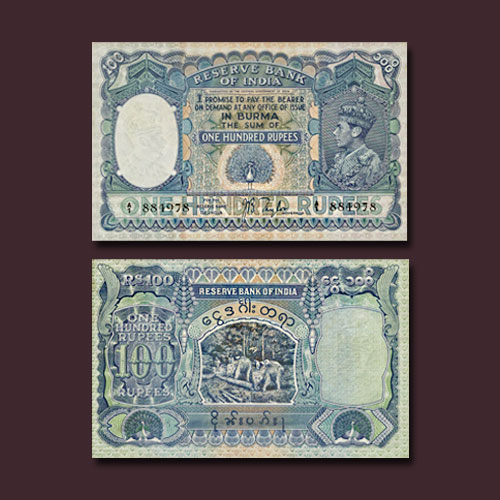Peacock Note by India for Burma
2020-02-12 Wed
The Government of India during British Raj issued banknotes for Burma. Burma did not issue any banknotes before the annexation by the British Empire. The three Anglo-Burmese wars led to the incorporation of Burma into the British Empire. Following these annexations was made a province of India. Banknotes of India were used in Burma following the British occupation of lower Burma in 1824.Burma was separated from the Indian Empire in 1935 when the Government of India Act came into force. However, the financial affairs of Burma continued to be managed by the Indian Government. This gave rise to a situation wherein the Central Monetary Authority of India issued notes for Burma.
This is the only instance where one country issued notes that were current in another during a civilian rule. It is unique in the history of paper money. An initial overprinted issued was followed by a special series of ‘Burma notes’ of the Reserve Bank India in 1937, also known as ‘Peacock Notes’. The notes were issued with the denominatin100, 1000 and 10,000 Rupee.
The obverse depicted the name of the banknote issuer “Reserve Bank of India” at the top center. The vignette of King George VI is at the right, and as a watermark at the left watermark window. The promissory note “I promise to pay the bearer on demand at any office of the issue in Burma the sum of” is overprinted at the center. The denomination of the note one hundred rupees is printed at the center of the note. Underneath it is an illustration of a dancing peacock. The monetary value description one hundred rupees is printed in large type as an underprint at the bottom.
Image Courtesy: https://www.worldbanknotescoins.com
Latest News
-
Ghiyath Shah as Heir Apparent
2025-09-25 ThuGhiyath Shah was the ruler of the Malwa Sultanate, reigning from 1456 to 1500. From 1456 to 1469, he...
-
Malwa Sultan Mahmud Shah Silver Coins
2025-09-11 ThuMalwa Sultan Mahmud Shah minted silver coins in round and square flans. <br><br> For round coins,...
-
Malwa Sultan Mahmud Shah Billon coin
2025-08-26 TueMalwa Sultan Mahmud Shah's billon coins followed three weight standards: 100 rati, 96 rati, and 80 r...
-
Fascinating Archaeological Facts on Postage Stamps - 91
2025-08-23 SatRhinoceros is one of the oldest land mammal species existing in India. There are five species of rhi...
-
Fascinating Archaeological Facts on Postage Stamps - 90
2025-08-23 SatUthiramerur, a Village in Kanchipuram, Tamil Nadu, is notable for its Temple inscriptions that descr...

